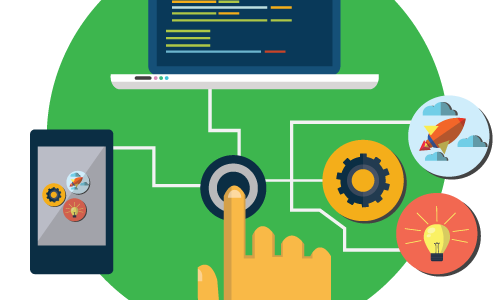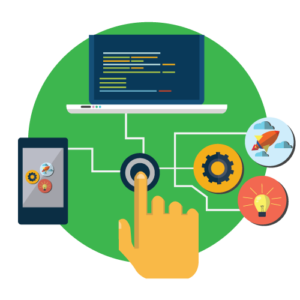
Embracing Agility: How Low-Code and No-Code Solutions Are Revolutionizing Traditional ERP Systems
In an era of rapid technological advancement and shifting business landscapes, traditional ERP (Enterprise Resource Planning) systems are struggling to keep up. Their rigid architecture and complex integration processes make them challenging to adapt to the fast-paced demands of today’s market. As a result, many large organizations are increasingly adopting low-code and no-code solutions, empowering business users to create custom applications tailored to their unique needs. This shift toward low-code and no-code platforms has led to greater agility, lower development costs, and faster time-to-market for tailored applications. Let’s dive into why this transition is happening, explore the benefits, and highlight real-world examples of successful low-code/no-code implementations.

The Limitations of Traditional ERP Systems
Traditional ERP systems were originally designed to centralize data, streamline operations, and automate business processes. However, their architecture often limits flexibility and customization, especially for non-technical users. The following are some of the main challenges that organizations face with traditional ERP systems:
- Slow Adaptability: Traditional ERPs are not well-suited for rapid changes. Adding new features or adapting to unique business requirements often requires significant customization, which can be time-consuming and expensive.
- Dependency on IT: Customizing or modifying ERP functionality typically requires specialized IT skills, creating a bottleneck as business users must rely on IT departments for updates and changes.
- High Costs and Long Implementation Times: ERP systems are known for their lengthy implementation cycles and high costs. Adjusting them to fit new needs can result in additional expenses.
- Complexity: ERPs are often complex, making it difficult for end-users to navigate or leverage all features effectively without extensive training.
In a world where agility and speed are crucial, these limitations can hinder an organization’s competitiveness. To address these challenges, many companies are turning to low-code and no-code platforms to supplement their existing ERPs.
_________________________________________________________________________________________________________________________
What Are Low-Code and No-Code Solutions?
Low-code and no-code platforms enable users to build applications with minimal coding or technical expertise. While low-code platforms still require some programming knowledge, no-code platforms are accessible to non-technical business users who can drag and drop components to create functional applications.
Benefits of Low-Code and No-Code Solutions
- Faster Development and Deployment: Applications can be developed and deployed quickly, enabling organizations to react to market changes and evolving customer demands.
- Cost-Effectiveness: By reducing dependency on IT resources and shortening development cycles, these platforms reduce the overall cost of creating applications.
- Greater Customization and Flexibility: Business users can develop applications that meet specific needs and adapt them as requirements change.
- Empowered Business Users: Non-technical employees can create and manage applications themselves, reducing the burden on IT departments.
- Seamless Integration with Existing Systems: Many low-code and no-code platforms offer integration capabilities with existing ERP systems, providing a smooth transition.
Let’s examine some real-world use cases that highlight the transformative impact of these platforms on businesses of all sizes.
_________________________________________________________________________________________________________________________
Use Cases of Low-Code and No-Code Solutions in Large Organizations
1. Customizing HR and Payroll Processes: A Case of Streamlined Efficiency
In large organizations, HR and payroll systems within ERP platforms often lack flexibility, requiring customized solutions to handle specific requirements. With low-code and no-code solutions, HR departments can quickly create applications tailored to regional payroll requirements, unique benefits, and other employee data processes.
- Example: A multinational corporation wanted to automate a specific payroll function unique to their European operations. Instead of waiting for an ERP vendor to develop the feature, the HR department used a no-code platform to build a custom application that integrates with their existing ERP. They were able to deploy the new application within weeks instead of months, saving time and costs while ensuring compliance with local regulations.
2. Sales and Marketing: Personalized Customer Portals for Enhanced Engagement
Sales and marketing departments often need to create customer-facing applications to manage relationships, track customer interactions, or support e-commerce initiatives. Traditional ERPs may offer some CRM functionalities but often lack the customization capabilities required for specific customer needs.
- Example: A retail company used a low-code platform to develop personalized customer portals that integrate seamlessly with their ERP. This allowed customers to track orders, access support, and manage their accounts in one place. The company could tailor each portal to meet the distinct needs of different customer segments without requiring extensive IT resources, leading to increased customer satisfaction and repeat sales.
3. Finance and Accounting: Streamlined Compliance and Reporting
Finance departments often face unique regulatory requirements that can vary significantly across regions. Traditional ERPs can be restrictive, making it difficult to generate specific financial reports or compliance documentation. With a low-code approach, finance teams can create custom applications to meet these regulatory requirements.
- Example: A global financial institution utilized a low-code platform to build an application for generating region-specific compliance reports. This application integrates with their ERP to pull relevant data, format it according to local regulations, and generate reports in a fraction of the time. By enabling quick adjustments as regulations change, the finance team can ensure compliance without relying on IT support for every update.
4. Supply Chain and Logistics: Optimizing Inventory Management
Supply chain and logistics teams require highly dynamic systems to manage inventory, track shipments, and optimize procurement. Traditional ERPs, however, may not allow enough customization for industry-specific needs.
- Example: A manufacturing company developed a no-code application to track shipments and monitor inventory levels in real time. The app integrates with their ERP, providing alerts and tracking insights on-demand. This customization allowed them to respond quickly to supply chain disruptions, reduce inventory holding costs, and improve overall efficiency.
5. Retail Operations: Customizing Point-of-Sale (POS) and Customer Experience Applications
Retail companies often need custom point-of-sale (POS) systems and customer-facing apps that align with specific branding and operational needs. Many large retailers are turning to no-code solutions to quickly develop these applications without heavily modifying their existing ERP.
- Example: A large retail chain built a no-code mobile POS application for store employees to process payments, check inventory, and offer promotions directly on the sales floor. The app is customized to match the company’s branding and connects to the ERP for real-time updates. By adopting this approach, the company improved customer service and decreased wait times, enhancing the overall in-store experience.
_________________________________________________________________________________________________________________________
Real-World Success Story: Siemens and Mendix Low-Code Platform
Siemens, a global technology powerhouse, is a prime example of how large organizations can leverage low-code solutions to supplement ERP functionality. The company adopted the Mendix low-code platform to develop applications that address unique needs across various departments, from manufacturing and logistics to customer service.
By empowering business users to create their own applications, Siemens was able to:
- Accelerate Innovation: Siemens reduced the time required to develop and deploy new applications, enabling rapid innovation across the company.
- Increase Efficiency: Business units were able to solve specific operational challenges without overhauling their entire ERP, leading to faster issue resolution and increased productivity.
- Enhance Customer Service: Custom applications allowed Siemens to improve customer service by providing tailored solutions to meet specific client demands.
The success Siemens experienced with low-code development encouraged them to use Mendix for ongoing digital transformation efforts, reducing dependency on external developers and increasing organizational agility.
_________________________________________________________________________________________________________________________
Choosing the Right Low-Code or No-Code Platform for ERP Integration
With numerous low-code and no-code platforms available, it’s essential to choose the right one that aligns with your business goals and integrates seamlessly with existing systems. Here are some key considerations:
- Integration Capabilities: Ensure the platform can integrate easily with your existing ERP and other business applications.
- User-Friendly Interface: Opt for a platform with a simple and intuitive design so business users can create and manage applications independently.
- Security and Compliance: Look for platforms that offer robust security features and meet industry compliance requirements.
- Scalability: Choose a solution that can grow with your organization, supporting more complex applications as your needs evolve.
Popular platforms like Mendix, OutSystems, and Microsoft Power Apps offer comprehensive features for large organizations, while smaller businesses may prefer simpler no-code solutions such as Appgyver or Bubble.
_________________________________________________________________________________________________________________________
Conclusion: A New Era of Agility and Innovation
Low-code and no-code platforms are transforming how organizations approach ERP customization, helping large companies remain agile and innovative without overhauling their core systems. By empowering business users, reducing development times, and enabling tailored solutions, these platforms are invaluable in a world where responsiveness is critical.
For large organizations, these solutions represent a strategic way to adapt to the fast-changing business environment while keeping costs under control and maintaining ERP stability. Whether in finance, logistics, or customer service, low-code and no-code platforms empower organizations to meet unique needs effectively, ensuring that they can continue to thrive in today’s dynamic markets.
